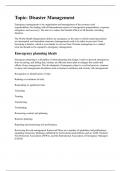Summary
Summary Disaster Management
- Course
- Institution
Emergency management is the organization and management of the resources and responsibilities for dealing with all humanitarian aspects of emergencies (preparedness, response, mitigation, and recovery). The aim is to reduce the harmful effects of all hazards, including disasters. The World Health ...
[Show more]



